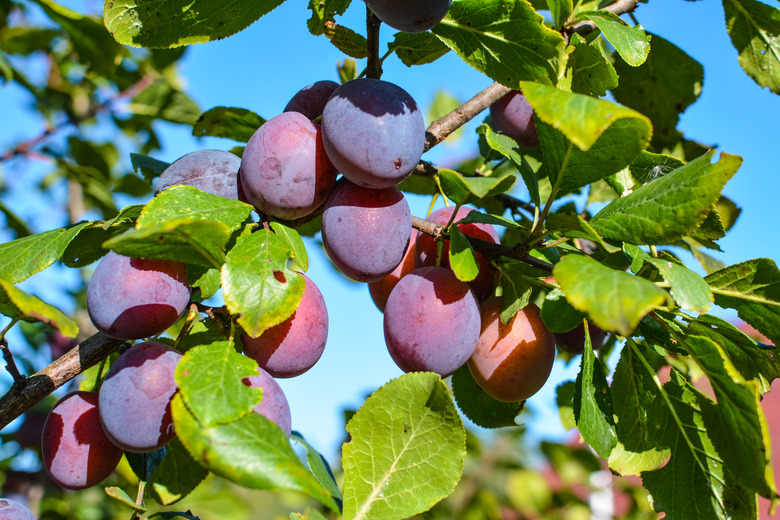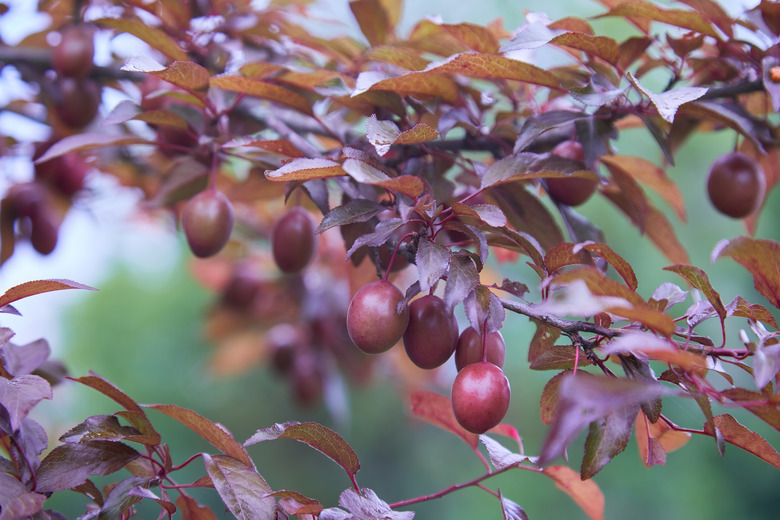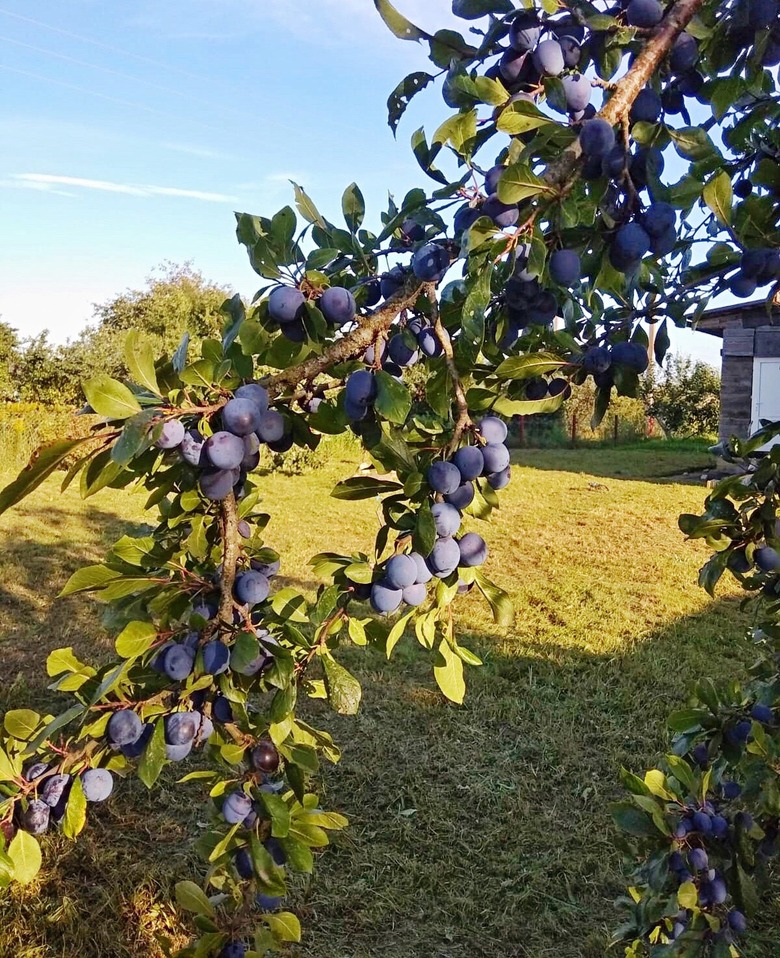How To Grow Plums
We may receive a commission on purchases made from links.
If you want to grow plums in your home orchard, you generally have three choices. You can grow the American plum (Prunus americana, USDA hardiness zones 5-9), the Japanese plum (Prunus salicina, zones 5-8) or the European plum (Prunus domestica, zones 5-9). Largely because it's self-fertile and has a wide growing range, the European plum is the most popular species in the United States.
Where Do Plums Grow Best?
Where Do Plums Grow Best?
Plums grow best in U.S. Department of Agriculture plant hardiness zones 5 through 8 or 9, depending on species and cultivar. You may have trouble growing plums in warmer areas. Deciduous trees evolved to deal with cold winter weather, and they expect it as part of their life cycle. If fruit trees don't get enough cold weather, called chill hours, they may fail to set fruit.
Chill hours are the number of hours a tree spends at temperatures below 45 degrees Fahrenheit. If you want to grow plums in a warmer climate, like Florida, you'll need to choose a plum cultivar that growers have adapted to fruit in warm climates with fewer chill hours, such as those in the Gulf series.
When Should You Plant Plums?
When Should You Plant Plums?
If you have a toddler who falls asleep in the car one night, you know that carrying him to bed and letting him wake up there is far less traumatic than waking him up and asking him to walk into the house. The same is true for plum trees.
It's best to plant your plum tree late in the winter or early in the spring while the tree is still in its winter dormancy. This way, it can simply wake up and start growing in the spring. Dormant trees can withstand frosts and freezes, so you can plant your tree as soon as you can get a shovel into the ground.
Growing Plum Trees
Growing Plum Trees
There's no question that a plum tree can add beauty to your landscape. These deciduous trees produce lovely pink or white spring blossoms, and like other deciduous trees, they put on a lovely autumn show. Attractive as they may be, however, gardeners don't often grow fruit trees for their looks.
Dwarf plum trees stretch only about 8 to 10 feet into the sky and spread 8 to 10 feet wide, making them a good fit in small home gardens. If you have the space, you can opt for a standard tree that will grow to 25 feet tall or more and spread just as wide. Dwarf trees are easier to handle in the home landscape, however. They're easier to cover when they need protection from frost and birds, and they require fewer chemicals if you must treat insect or disease problems.
Gardeners grow plums to eat, and they eat well. A single plum tree can produce about 1 to 1 1/2 bushels of sweet yet tangy plums every year. This translates to 40 or 50 pounds of fruit, which is more than enough for eating raw, making jam and sharing with friends or food banks. Plums also tend to be late fruiters, so you can count on them to gear up as your other fruit trees wind down.
Transplanting a Plum Sapling
Transplanting a Plum Sapling
To improve performance and achieve desired qualities, such as disease resistance, nurseries propagate plums by grafting them onto rootstocks with the desired traits. This means that you can plant the pit from the center of your plum and grow a tree, but it will likely be unhealthy, vulnerable to disease and nothing like the tree from which you harvested it. Planting young trees is a much more reliable option.
If you're planting more than one tree, make sure you space individuals about 20 feet apart. Dwarf trees need to be only about 10 to 15 feet apart. Unwrap bare root trees and place the roots in a bucket of water while digging the planting holes.
To plant your tree, dig a planting hole twice as wide and just as deep as the plant's root ball. Build a small dirt mound in the middle of the hole and place your tree on top of it. Take the roots of your plum tree and arrange them so that they fan out over the dirt mound and point toward the earth. Your planting hole should be large enough to accommodate the spread roots without bending them.
Backfill your planting hole. If you have heavy clay soil that drains slowly, incorporate lots of organic matter over the entire planting site; avoid amending just the planting hole. Tamp gently and water your tree deeply after planting.
After planting, the spot where the tree was grafted onto the roots should still be visible, sitting 1 to 2 inches above the ground. This is absolutely imperative. If you plant the graft union too deeply, it will start to sprout roots of its own and bypass the rootstock onto which it was grafted. This can quickly turn a dwarf tree into a much larger standard tree of a less desirable quality and can cause other problems in your home orchard.
Caring for Plums
Caring for Plums
Plums enjoy full sun and grow best when they receive six to eight hours of direct sunlight a day. During its first year or two of life, your plum tree will need to be watered as often as is necessary to keep the soil moist but not wet. This usually requires watering once or twice a week. Once established, your tree will only need about 1 inch of water every 10 days.
Fruit trees are incredibly self-sufficient and often don't need fertilization. Until your plum tree starts bearing fruit, usually at around 3 or 4 years of age, you should expect its spring shoots to grow at least 15 inches per year. Once bearing begins, shoots should grow 8 inches per year. If your tree is reaching these goals, skip the fertilizer. If it's not, test the soil to see exactly which nutrients — and how much of each nutrient — you need to add to the soil.
Your plums are more likely to need fertilizer if you don't help them eliminate the competition. Weeds and grass growing close to your tree may beat it to the nutrients found in your soil. To prevent this and make sure your plums get the nutrition they need, keep a 3-foot radius around your tree clear of weeds and other plants. You can mulch around the tree to help keep down weeds, but make sure you rake up and dispose of the mulch before winter so you don't give insects, fungi and bacteria a place to hide.
Plum trees benefit from pruning and can produce more fruit when properly maintained; to prevent the spread of pests and diseases sterilize your cutting tools before you begin pruning. To shape your plum tree, create a central leader that grows from the trunk. Allow branches to grow out from this central leader, spacing them 5 to 8 inches apart and stagger the branches so that they don't sit one on top of the other. You should also remove dead, diseased and crisscrossing limbs.
Proper pruning allows ample sunlight to reach the center of the tree's canopy and improves air circulation, which minimizes the risk of fungal infections. Prune young plum trees in late winter or early spring, while still dormant, or in midsummer to slow growth and control the size. Prune mature plum trees in summer to avoid infection by silver leaf and other diseases. Trim as needed to remove buds and growth below the graft line, rapidly growing branches and water sprouts.
When fruit begins to form on your tree in the summer, keep an eye on how much is forming. If it looks like a lot, thin the young plums to about 2 inches apart. This will prevent your tree from overbearing, which can cause the weight of the fruit to break the tree's branches.
Harvesting Your Plums
Harvesting Your Plums
European plums, which is what most home gardeners grow, taste best when they are allowed to ripen on the tree. They're ready to harvest when they give a bit when you squeeze them. Ripe fruit will come away from the tree easily with a twist and are quite easy to harvest.
Plums are typically ready to pick around September. You'll likely need to pull plums off your tree a few times rather than getting all of your plums in one big haul. Unfortunately, plums don't last long, though you can store them in the refrigerator at 31 or 32 degrees for a maximum of four weeks. If you need to keep them longer, remove the pits and freeze them or make some jams and jellies.
Winterizing Plum Trees
Winterizing Plum Trees
Like all deciduous trees, plum trees get themselves ready for winter by dropping their leaves and entering a period of dormancy. All you need to do is rake up any fallen leaves or old mulch around the tree. This ensures that bothersome insects and fungi don't have a safe place near your tree to spend the winter before infecting it in springtime.
You will need to watch your tree in early spring, however. Late cold snaps can cause problems for trees that have already started to form flowers. If your tree has started to blossom but the weather forecast is calling for temperatures below 30 degrees Fahrenheit, cover your plum tree with a tarp or blanket to keep it warm and save the buds.
If you can't get to your tree in time, don't worry. The cold will kill your new buds but not the tree itself. This year's plum crop may prove smaller than usual, but your tree will get back on track next year.
Monitoring for Pests and Other Problems
Monitoring for Pests and Other Problems
Humans are not the only animals that like plums. Birds will often swoop down and steal a few plums from your tree. If they're taking more of your fruit than you would like, simply place bird netting over your tree to keep them out.
Rodents also like plum trees, but they tend to eat the bark in the winter when food is scarce rather than bothering the fruit. If you notice bald patches on your plum tree's trunk during the winter, apply tree wrap to keep the critters at bay.
Are you finding weird, crescent-shaped marks on your plums? You probably have plum curculios in your tree. These ugly brown weevils are a serious problem and can wreak havoc on a plum crop. To thwart them, keep the area around your tree clean.
You can lay a tarp under the tree, shake it and kill any weevils that fall onto the tarp. You'll likely need to treat your tree with insecticides to solve the problem completely, however. Apply a pesticide in the spring that contains carbaryl, spinosad or esfenvalerate.
Plum maggots can also destroy some of your fruit. As the larval form of the plum moth, these small insects burrow into your plums and feed on them as they grow. You can easily avoid issues by carefully examining your plums shortly after fruit set; remove and destroy any plums with visible plum maggot tunnels. This stops the maggots before they get a chance to mature and reproduce, stopping their life cycle before they become a bigger problem.
Aside from the plum curculios and maggots, you're most likely to see the usual suspects on your plum tree. Aphids, mites, scale insects, beetles and stink bugs may all visit your tree at some point. You can remove all these pests with a spray of water from your garden hose or kill them using insecticidal soap or neem oil.
Diagnosing and Treating Diseases
Diagnosing and Treating Diseases
Like all plants, plums are susceptible to bacterial and fungal diseases, and they're most likely to suffer when growing conditions are suboptimal. To minimize disease, rake up debris around your trees, prune them properly for good air circulation and irrigate them at soil level using drip irrigation rather than overhead irrigation.
Even with proper gardening hygiene, plums often develop brown rot and powdery mildew. Brown rot appears as brown or gray spots on the plant. It can ultimately lead to both twig and blossom blights. To prevent brown rot and the other issues it can cause, spray your tree with a fungicide once in the spring and again two to three weeks before harvest.
Plums often contract powdery mildew as well. Unlike brown rot, however, powdery mildew is primarily cosmetic and generally not cause for concern. Your plant will look as if someone sprinkled it with white flour, but it will still produce plums and function well. If powdery mildew bothers you, you can treat with a sulfur fungicide in spring.


